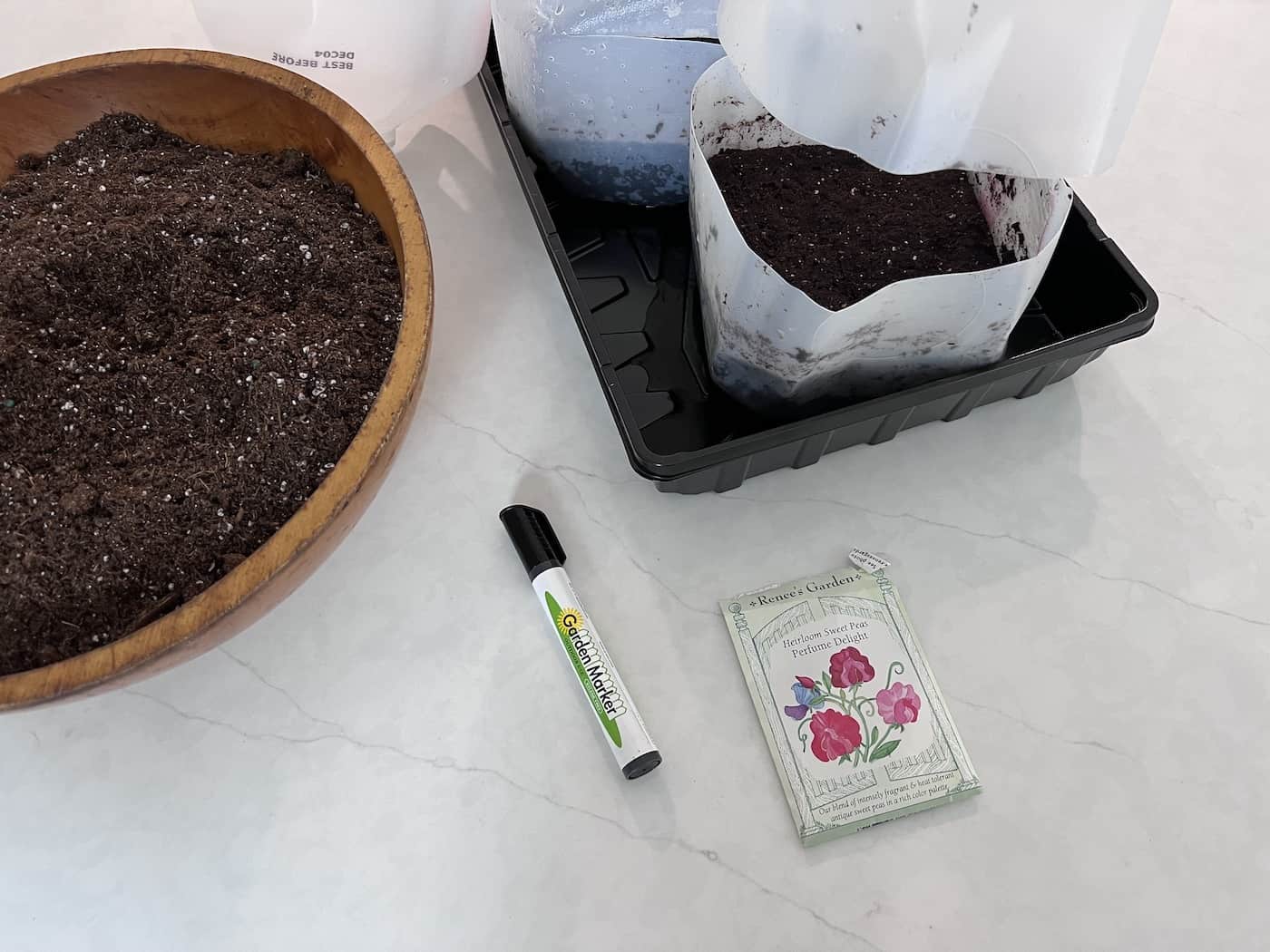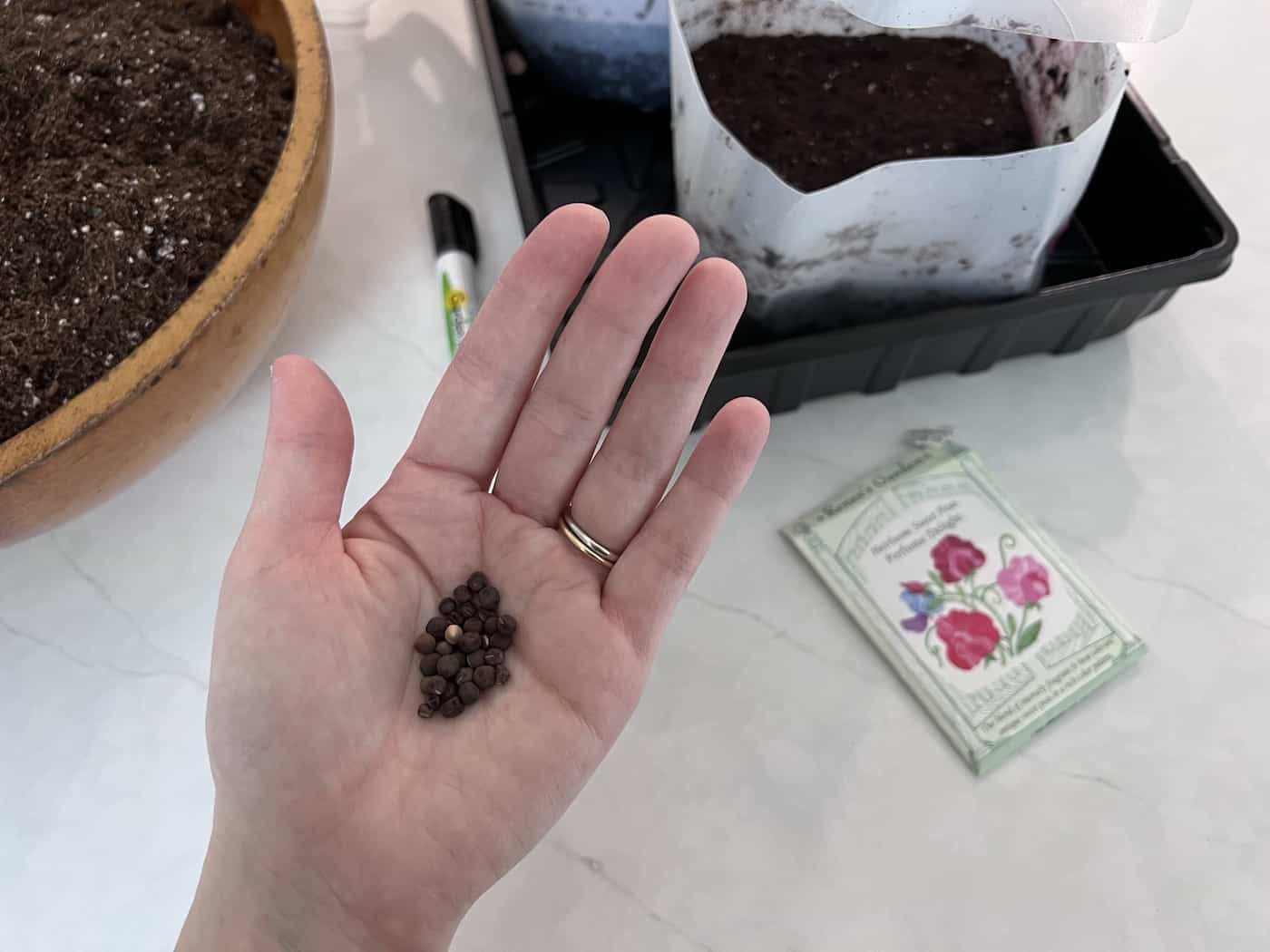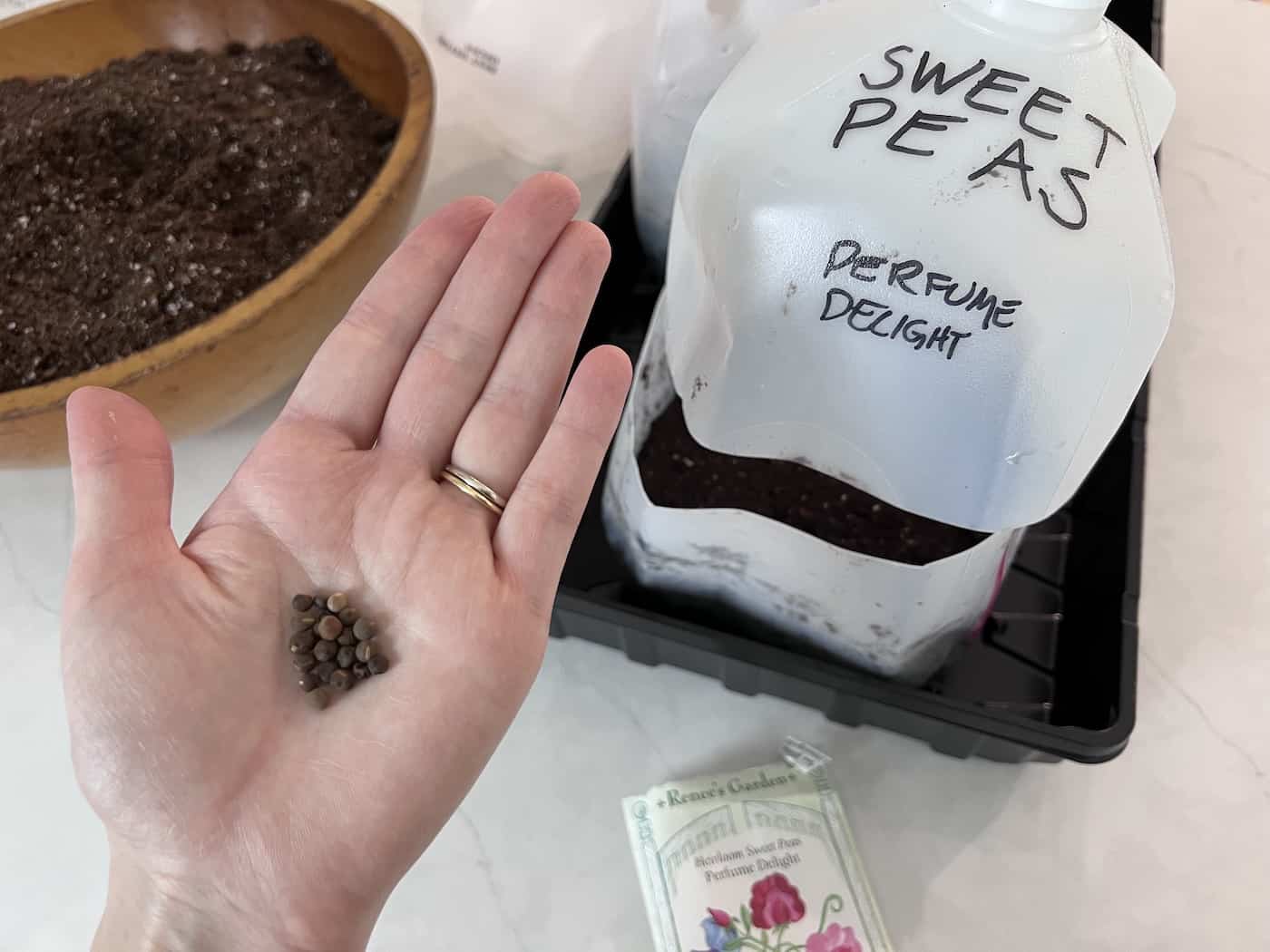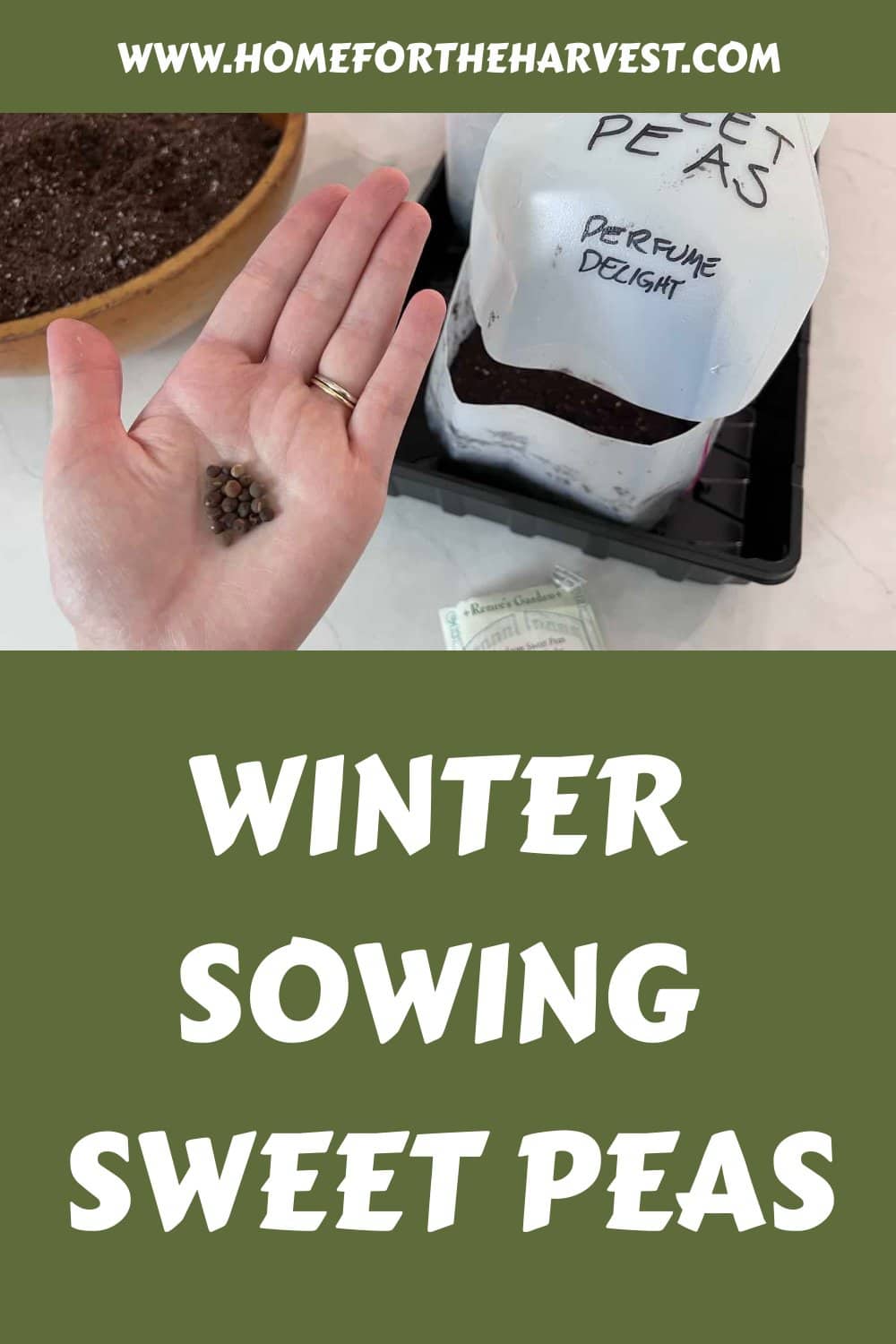Welcome to the winter sowing sweet peas party! If you’re looking for a fun and easy way to add some color and life to your garden, then look no further.
Winter sowing is an excellent option that doesn’t require any prior gardening experience – all you need is patience and determination. It’s time to grab your milk jugs or take-out boxes. We will discuss the best times of year for starting this process, what containers work best, how to prepare seed flats, planting techniques as well as transplanting tips.

Winter sowing sweet peas
Winter sowing sweet peas is a great way to get your garden off to an early start. By planting your seeds outdoors in the winter months, you can enjoy blooms earlier than if you had started them indoors. Sweet peas are especially well-suited for this method of gardening because they require cooler temperatures and moist soil to germinate.
To begin winter sowing sweet peas, gather some containers such as plastic milk jugs, old takeout containers, or yogurt cups with lids. For jugs, cut them in half. For all containers, make sure there are drainage holes in the sides near the bottom so excess water can escape.
Fill each container about halfway with potting soil and add a few pea seeds on top of it. Cover the containers with their lids or cover halves and place them outside in a sunny spot where they will be exposed to rain and snow throughout the winter months.
When spring arrives, take off the tops from your containers and check for signs of growth inside – you should see small seedlings sprouting up. If needed, give them extra protection by covering them with bird netting or shade cloth during particularly cold days or nights until they become established enough that they can handle more extreme weather conditions on their own.
As soon as all danger of frost has passed, transplant your seedlings into larger pots or directly into your garden beds where they will have plenty of room to grow tall and produce lots of fragrant flowers throughout summertime.
Watering is important when growing sweet peas; keep an eye out for dry patches in between rainshowers so that plants don’t suffer from drought stress during hot spells. You may also want to provide some support for taller varieties by setting up stakes around plants before vines become too long – this helps prevent breakage due to strong winds or heavy rainfall later on down the line. Finally, remember that sweet pea flowers attract pollinators like bees which help ensure successful harvests come harvest time, so let those blossoms bloom.
Winter sowing sweet peas is a great way to get an early start on your garden, and with the right timing you can enjoy beautiful blooms in no time. Next, let’s take a look at when to begin winter sowing sweet peas.
When to start winter sowing sweet peas?
Winter is the best time to start winter sowing, when temperatures are consistently below freezing. Usually this is during December-March. This gives the seeds enough time to germinate and grow before spring planting begins.
When it comes to choosing a container for your sweet pea seeds, there are many options available. You can use plastic containers such as milk jugs or yogurt cups with holes punched in them for drainage, or you can purchase special seed starting trays from your local garden center. Whatever container you choose should be large enough to hold several inches of soil and have adequate drainage holes so that excess water can escape.
Once you’ve chosen your containers, it’s important to prep them properly before adding any soil or seeds. Start by washing out each container with soap and water and then rinse thoroughly with clean water until all traces of soap are gone. Once they’re dry, add some potting mix into each one until it’s about halfway full; this will provide a good environment for your seeds to germinate in once planted.
Now that your containers are prepped and ready, it’s time to plant. Sweet peas should be planted at least 1/2 inch deep into the soil; if you’re using multiple plants per container make sure they’re spaced evenly apart so they don’t crowd each other out as they grow larger over time. After planting, lightly cover the surface of the soil with more potting mix and give everything a gentle watering until moist but not saturated – too much moisture could cause mold growth which could harm your plants’ health down the line.
Once your sweet pea seedlings have grown big enough (usually around 4-6 weeks), it is time for transplanting. When transplanting outdoors, make sure to dig wide trenches rather than narrow ones. This will help prevent root damage during the process of transplantation and also allow plenty of room for roots to spread out after being transplanted into their new home outside in nature.
Starting sweet peas in the winter is a great way to get a jump start on your gardening season. With the right containers and soil, you can easily begin sowing these seeds now for beautiful blooms in the spring. Next, let’s look at what containers are best for winter sowing sweet peas.
Container ideas to use
When winter sowing sweet peas, you need to use a container that has drainage holes and can be sealed shut. Milk jugs are one of the most popular options as they’re easy to find and relatively inexpensive. You can also use take-out boxes or even plastic bags with holes punched in them. Just make sure your container is large enough for the seedlings to grow without becoming overcrowded.
If you have limited space, consider using smaller containers such as yogurt cups or egg cartons. These will give your plants plenty of room while still allowing you to maximize the number of plants per square foot. If you want something more decorative, terracotta pots are an excellent choice – just make sure they have drainage holes at the bottom, so excess water doesn’t drown your seedlings.

How to prep winter sowing seed flats?
Preparing your seed flats is an important step in the winter sowing of sweet peas. If you’re using milk jugs for winter sowing, cut them in half. And for all containers, add drainage holes in the bottom.
To start, fill each flat with a few inches of potting soil or garden-grade topsoil mixed with some compost material such as peat moss, manure, or leaf mold. This mixture should be light enough so that it won’t compact when watered but still retain enough moisture for the seeds to germinate properly. If necessary, you can also add some sand to help improve drainage if needed.
Next, moisten the soil by adding water until it’s evenly damp throughout without being too wet or dry – just like a wrung-out sponge. It’s best to use lukewarm water since cold water may shock tender young roots and cause them not to develop properly.

Planting sweet pea seeds (winter sowing method)
Place each seed about 1/2 inch deep into the soil mix. Cover lightly with more soil mix. Tape the container shut – not airtight but just so the cover doesn’t blow away.
Place them outdoors in an area that gets plenty of sunlight (at least 6 hours per day) and water regularly until they sprout in the spring. They also need to be in a spot exposed to rain/snow.
Once they’ve grown their first set of true leaves it’s time for transplanting – carefully move them from their original container into larger ones filled with fresh potting soil mixture or directly into prepared beds outside in warmer climates where frost isn’t expected anymore.
Transplanting sweet pea seedlings
Once your sweet peas have grown large enough for transplanting outdoors (about 4 inches tall), wait for an overcast day or evening when temperatures are milder than usual—this will help reduce shock from sun exposure and wind chill.
Prepare your garden bed by loosening the soil with a shovel or tiller, removing any weeds, and adding compost if needed. Dig holes approximately 3 inches deep and 8 inches apart; place each seedling in its own hole at roughly the same depth as it was growing in its container. Gently firm down around each plant to ensure good contact between roots and soil then water thoroughly after planting is complete.
Caring for sweet pea plants in the garden
Sweet peas need plenty of sunshine but also benefit from some afternoon shade during hot summer months; aim for 6 hours of direct sunlight daily if possible. Keep plants well watered throughout their growing season—they should receive at least 1 inch of water weekly either through rainfall or supplemental irrigation such as drip hoses or sprinklers (avoid overhead watering which can cause fungal diseases).
Mulching around plants helps retain moisture while keeping weeds away; use organic materials like straw, grass clippings, shredded leaves etc., applied 2-3 inches thick all around each plant’s base without touching stems or foliage itself. Fertilize once every two weeks using a balanced fertilizer formulated specifically for flowering plants. This will help promote healthy growth and more blooms
FAQs about winter sowing sweet pea seeds
How do you sow sweet peas in the winter?
Sweet pea seeds can be sown in the winter by planting them in an empty old takeout container with some moist potting mix. Close the container, place it outdoors in the elements, and check it in the spring for sprouts.
Should sweet pea seeds be soaked before sowing?
Yes, sweet pea seeds should usually be soaked before sowing, but you don’t need to do this when winter sowing. Soaking helps to soften the seed coat and encourages germination. Winter sowing takes long enough on its own that you don’t need to do this extra step. The seeds will soak in the flat outdoors.
Before you go…
With just a few simple steps, you can have beautiful blooms of sweet pea flowers in no time! Start by selecting the right containers and prepping your seed flats. Then plant and transplant your sweet pea seeds or seedlings at the right time for optimal growth. With winter sowing, you’ll be able to enjoy beautiful blooms of sweet peas come springtime without having to worry about starting too early or late!






